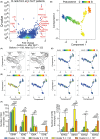RNA sequencing of single allergen-specific memory B cells after grass pollen immunotherapy: Two unique cell fates and CD29 as a biomarker for treatment effect
- PMID: 36153670
- PMCID: PMC10952829
- DOI: 10.1111/all.15529
RNA sequencing of single allergen-specific memory B cells after grass pollen immunotherapy: Two unique cell fates and CD29 as a biomarker for treatment effect
Abstract
Background: Sublingual immunotherapy (SLIT) for grass pollen allergy can modify the natural history of allergic rhinitis and is associated with increased allergen-specific IgG4 . IgG4 competitively inhibits functional IgE on the surface of effector cells, such as mast cells and basophils, from binding to allergens. To further understand the important role memory B-cell (Bmem) responses play in mediating the beneficial effects of SLIT, we assessed changes in allergen-specific Bmem subsets induced by SLIT for grass pollen allergy.
Methods: Blood samples were collected twice outside the pollen season from twenty-seven patients with sensitization to ryegrass pollen (RGP; Lolium perenne) and seasonal rhinoconjunctivitis. Thirteen received 4-month pre-seasonal SLIT for grass pollen allergy, and 14 received standard pharmacotherapy only. Single-cell RNA sequencing was performed on FACS-purified Lol p 1-specific Bmem before and after SLIT from four patients, and significant genes were validated by flow cytometry on the total cohort.
Results: Four months of SLIT increased RGP-specific IgE and IgG4 in serum and induced two Lol p 1-specific Bmem subsets with unique transcriptional profiles. Both subsets had upregulated expression of beta 1 integrin ITGB1 (CD29), whereas IGHE (IgE), IGHG4 (IgG4 ), FCER2 (CD23), and IL13RA1 were upregulated in one subset. There was an increase in the proportion of Lol p 1+ Bmem expressing surface IgG4 , CD23, and CD29 after SLIT.
Conclusions: A clinically successful 4 months course of SLIT for grass pollen allergy induces two transcriptionally unique Bmem fates. Associated changes in surface-expressed proteins on these Bmem subsets can be used as early biomarkers for treatment effects.
Keywords: allergen immunotherapy; biomarkers; grass pollen allergy; memory B cells; transcriptomics.
© 2022 The Authors. Allergy published by European Academy of Allergy and Clinical Immunology and John Wiley & Sons Ltd.
Conflict of interest statement
MCvZ, REO’H, and CIM are inventors on a patent application related to this work. All the other authors declare that they have no relevant conflicts of interest.
Figures







References
-
- García‐Mozo H. Poaceae pollen as the leading aeroallergen worldwide: a review. Allergy. 2017;72:1849‐1858. - PubMed
-
- Blaiss MS, Hammerby E, Robinson S, Kennedy‐Martin T, Buchs S. The burden of allergic rhinitis and allergic rhinoconjunctivitis on adolescents: a literature review. Ann Allergy Asthma Immunol. 2018;121:43‐52. - PubMed
-
- Nathan RA. The burden of allergic rhinitis. Allergy Asthma Proc. 2007;28:3‐9. - PubMed
-
- Schatz M. A survey of the burden of allergic rhinitis in the USA. Allergy. 2007;62:9‐16. - PubMed
-
- Schoenwetter WF, Dupclay L, Appajosyula S, Botteman MF, Pashos CL. Economic impact and quality‐of‐life burden of allergic rhinitis. Curr Med Res Opin. 2004;20:305‐317. - PubMed
Publication types
MeSH terms
Substances
LinkOut - more resources
Full Text Sources
Other Literature Sources
Medical
Miscellaneous

